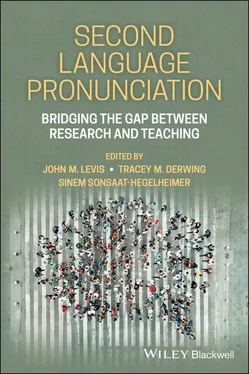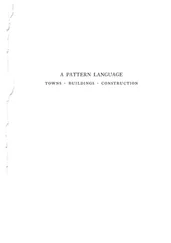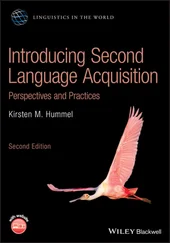Second Language Pronunciation
Здесь есть возможность читать онлайн «Second Language Pronunciation» — ознакомительный отрывок электронной книги совершенно бесплатно, а после прочтения отрывка купить полную версию. В некоторых случаях можно слушать аудио, скачать через торрент в формате fb2 и присутствует краткое содержание. Жанр: unrecognised, на английском языке. Описание произведения, (предисловие) а так же отзывы посетителей доступны на портале библиотеки ЛибКат.
- Название:Second Language Pronunciation
- Автор:
- Жанр:
- Год:неизвестен
- ISBN:нет данных
- Рейтинг книги:5 / 5. Голосов: 1
-
Избранное:Добавить в избранное
- Отзывы:
-
Ваша оценка:
- 100
- 1
- 2
- 3
- 4
- 5
Second Language Pronunciation: краткое содержание, описание и аннотация
Предлагаем к чтению аннотацию, описание, краткое содержание или предисловие (зависит от того, что написал сам автор книги «Second Language Pronunciation»). Если вы не нашли необходимую информацию о книге — напишите в комментариях, мы постараемся отыскать её.
Second Language Pronunciation: Bridging the Gap Between Research and Teaching
Second Language Pronunciation: Bridging the Gap Between Research and Teaching
Second Language Pronunciation — читать онлайн ознакомительный отрывок
Ниже представлен текст книги, разбитый по страницам. Система сохранения места последней прочитанной страницы, позволяет с удобством читать онлайн бесплатно книгу «Second Language Pronunciation», без необходимости каждый раз заново искать на чём Вы остановились. Поставьте закладку, и сможете в любой момент перейти на страницу, на которой закончили чтение.
Интервал:
Закладка:
Journal of Second Language Pronunciation . Amsterdam: John Benjamins.
This triannual journal is the go-to site for top pronunciation researchers. The journal welcomes submissions that integrate research and practice.
PSLLT Proceedings
The Proceedings of the Pronunciation in Second Language Learning and Teaching Conference are freely available: https://apling.engl.iastate.edu/conferences/pronunciation-in-second-language-learning-and-teaching-conference/psllt-archive.
Each Proceedings has a section on Teaching Tips, contributed by expert practitioners, with clear, step-by-step directions for activities, along with the rationale for each. Every issue of the Proceedings also has several short, accessible articles on pronunciation teaching, often with suggestions for activities.
Pronunciationforteachers.com
This website is intended to assist language teachers by offering short, accessible essays on key concepts in pronunciation and pointing to several resources and activities that could be incorporated into any language class.
Author Biographies
Tracey M. Derwing is Professor Emeritus, the University of Alberta, and an Adjunct Professor at Simon Fraser University. She has researched L2 pronunciation, especially the relationships among intelligibility, comprehensibility, fluency, and accent. She has also examined interventions enhancing native speakers’ comprehension of L2 accented speech. Much of her research concerns the successful social integration of immigrants and refugees.
John M. Levis is Professor of Applied Linguistics at Iowa State University. He is the founding editor of the Journal of Second Language Pronunciation , the founder of the Pronunciation in Second Language Learning and Teaching Conference , the co-editor of the Pronunciation in Second Language Learning and Teaching Proceedings , and the co-developer of pronunciationforteachers.com. He is co-editor of several books, including The Handbook of English Pronunciation (2015), Social Dynamics in Second Language Accent (2014), and Critical Concepts in Linguistics: Pronunciation (2017). He is also the author of Intelligibility, Oral Communication, and the Teaching of Pronunciation (2018).
Sinem Sonsaat-Hegelheimer is Assistant Professor at Iowa State University. She is the editorial assistant of Journal of Second Language Pronunciation , the co-developer of pronunciationforteachers.com, and the chair of Speech Pronunciation and Listening Interest Section of TESOL International Association. Sinem’s interests include pronunciation teaching, materials evaluation and development, and computer-assisted language learning. She has published in TESOL Quarterly , CATESOL Journal , and The Routledge Handbook of English Pronunciation .
References
1 Baker, A. (2021). ‘She’ll be right’: Development of a coaching model to clear and fluent pronunciation in Australia. English Australia Journal, 37(1), 27–39.
2 Baker, A., & Murphy, J. (2011). Knowledge base of pronunciation teaching: Staking out the territory. TESL Canada Journal, 28(2), 29–50. doi.org/10.18806/tesl.v28i2.1071
3 Burns, A. (2009). Action research. In J. Heigham & R. Croker (Eds.), Qualitative research in applied linguistics (pp. 112–134). Palgrave Macmillan. doi.org/10.1057/9780230239517_6
4 Darcy, I., Ewert, D., & Lidster, R. (2012). Bringing pronunciation instruction back into the classroom: An ESL teachers’ pronunciation “toolbox”. In J. Levis & K. LeVelle (Eds.), Proceedings of the 3rd Pronunciation in Second Language Learning and Teaching Conference, September 2011 (pp. 93–108). Iowa State University.
5 Derwing, T. M. (in press). Twelve lessons learned from teaching teachers to teach pronunciation. In V. Sardegna & A. Jarosz (Eds.), English pronunciation teaching: Theory, practice, and research findings. Multilingual Matters.
6 Derwing, T. M., & Munro, M. J. (2015). Pronunciation fundamentals: Evidence-based perspectives for L2 teaching and research. John Benjamins. doi.org/10.1075/lllt.42
7 Derwing, T. M., Waugh, E., & Munro, M. J. (2021). Pragmatically speaking: Preparing adult ESL students for the workplace. Applied Pragmatics, 3(2), 107–135. doi.org/10.1075/ap.20001.der
8 El Majidi, A., de Graaff, R., & Janssen, D. (2018). Students’ perceived effect of in-class debates in second language learning. The European Journal of Applied Linguistics and TEFL, 7(1), 35–57.
9 El Majidi, A., de Graaff, R., & Janssen, D. (2021). Debate as a pedagogical tool for developing speaking skills in second language education. Language Teaching Research.
10 Foote, J. A., Holtby, A. & Derwing, T. M. (2011). Survey of pronunciation teaching in adult ESL programs in Canada, 2010. TESL Canada Journal, 29(1), 1–22. doi.org/10.18806/tesl.v29i1.1086
11 Foote, J., & McDonough, K. (2017). Using shadowing with mobile technology to improve L2 pronunciation. Journal of Second Language Pronunciation, 3(1), 34–56. doi.org/10.1075/jslp.3.1.02foo
12 Foote, J. A., Trofimovich, P., Collins, L., & Urzúa, F. S. (2016). Pronunciation teaching practices in communicative second language classes. The Language Learning Journal, 44(2), 181–196. doi.org/10.1080/09571736.2013.784345
13 French, L. M., Gagné, N., & Collins, L. (2020). Long-term effects of intensive instruction on fluency, comprehensibility and accentedness. Journal of Second Language Pronunciation, 6(3), 380–401. doi.org/10.1075/jslp.20026.fre
14 Galante, A., & Thomson, R. I. (2017). The effectiveness of drama as an instructional approach for the development of second language oral fluency, comprehensibility, and accentedness. TESOL Quarterly, 51(1), 115–142. doi.org/10.1002/tesq.290
15 Gluhareva, D., & Prieto, P. (2017). Training with rhythmic beat gestures benefits L2 pronunciation in discourse-demanding situations. Language Teaching Research, 21(5), 609–631. doi.org/10.1177/1362168816651463
16 Goodwin, J. (2005). The power of context in teaching pronunciation. In J. Frodesen & C. Holten (Eds.), The power of context in language teaching and learning (pp. 225–236). Boston: Thomson Heinle.
17 Graham, C. (1978). Jazz chants: Rhythms of American English for students of English as a second language. Oxford University Press.
18 Hardison, D. M. (2004). Generalization of computer assisted prosody training: Quantitative and qualitative findings. Language Learning & Technology, 8(1), 34–52. doi.org/10125/25228
19 Hirata, Y. (2004). Computer assisted pronunciation training for native English speakers learning Japanese pitch and durational contrasts. Computer Assisted Language Learning, 17(3–4), 357–376. doi.org/10.1080/0958822042000319629
20 Huensch, A. (2019). Pronunciation in foreign language classrooms: Instructors’ training, classroom practices, and beliefs. Language Teaching Research, 23(6), 745–764. doi.org/10.1177/1362168818767182
21 Jones, T. (Ed.). (2016). Pronunciation in the classroom: The overlooked essential. TESOL Press.
22 Kauffman, C. (2010). The last word: How to move from good to great coaching by drawing on the full range of what you know. Coaching: An International Journal of Theory, Research and Practice, 3(2), 87–98. doi.org/10.1080/17521882.2010.509910
23 Levis, J. M. (2017). Evidence-based pronunciation teaching: A pedagogy for the future. Journal of Second Language Pronunciation, 3(1), 1–8. doi.org/10.1075/jslp.3.1.001evi
24 Levis, J. M. (2018). Intelligibility, oral communication, and the teaching of pronunciation. Cambridge University Press.
25 Levis, J. M., & Grant, L. (2003). Integrating pronunciation into ESL/EFL classrooms. TESOL Journal, 12(2), 13–19.
Читать дальшеИнтервал:
Закладка:
Похожие книги на «Second Language Pronunciation»
Представляем Вашему вниманию похожие книги на «Second Language Pronunciation» списком для выбора. Мы отобрали схожую по названию и смыслу литературу в надежде предоставить читателям больше вариантов отыскать новые, интересные, ещё непрочитанные произведения.
Обсуждение, отзывы о книге «Second Language Pronunciation» и просто собственные мнения читателей. Оставьте ваши комментарии, напишите, что Вы думаете о произведении, его смысле или главных героях. Укажите что конкретно понравилось, а что нет, и почему Вы так считаете.












